200+ Linking Words – Full List, Examples
| Candace Osmond
Candace Osmond
Candace Osmond studied Advanced Writing & Editing Essentials at MHC. She’s been an International and USA TODAY Bestselling Author for over a decade. And she’s worked as an Editor for several mid-sized publications. Candace has a keen eye for content editing and a high degree of expertise in Fiction.

Worried that your essay lacks structure and coherence? Perhaps you should use linking words, transition words, or connectors to give it a boost.
Linking words join separate sentences to improve writing flow. You can also find them mid-sentence to connect clauses.
Read on as I show you the definition and types of linking words in English. I also list examples of linking words under every category, and I whipped up a helpful worksheet to test your skills.

What Are Linking Words?
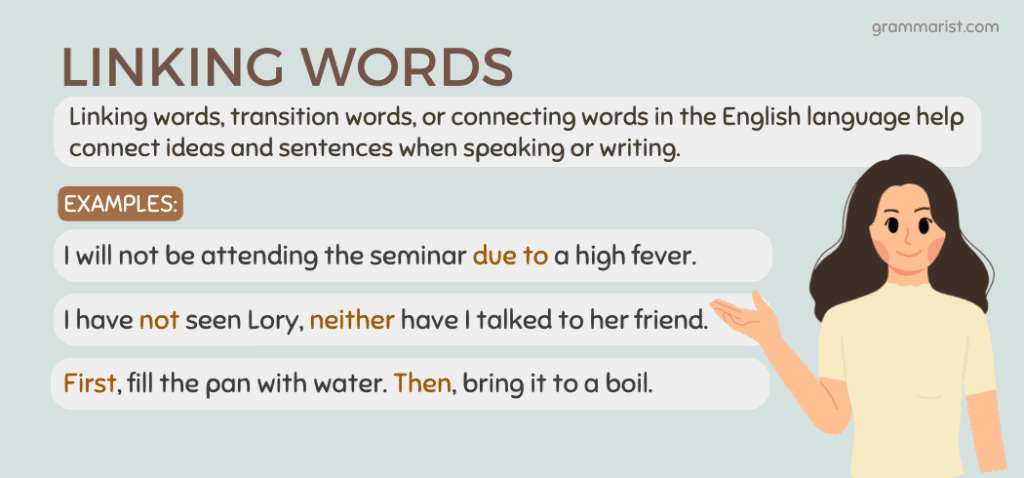
Linking words, transition words, or connecting words in the English language help connect ideas and sentences when speaking or writing.
Linking words and phrases are connectors or transitional phrases. They are also part of formal language, so you’ll find them in academic writing, opinion writing, critical essays, dialectic essays , journalism, and business documents.
Some linking verbs link clauses within a sentence, such as although, in case, and whatever. That means you can find them in the middle of sentences from time to time. Others link two complete sentences, such as besides, as a result, and however.
List of Transition Words
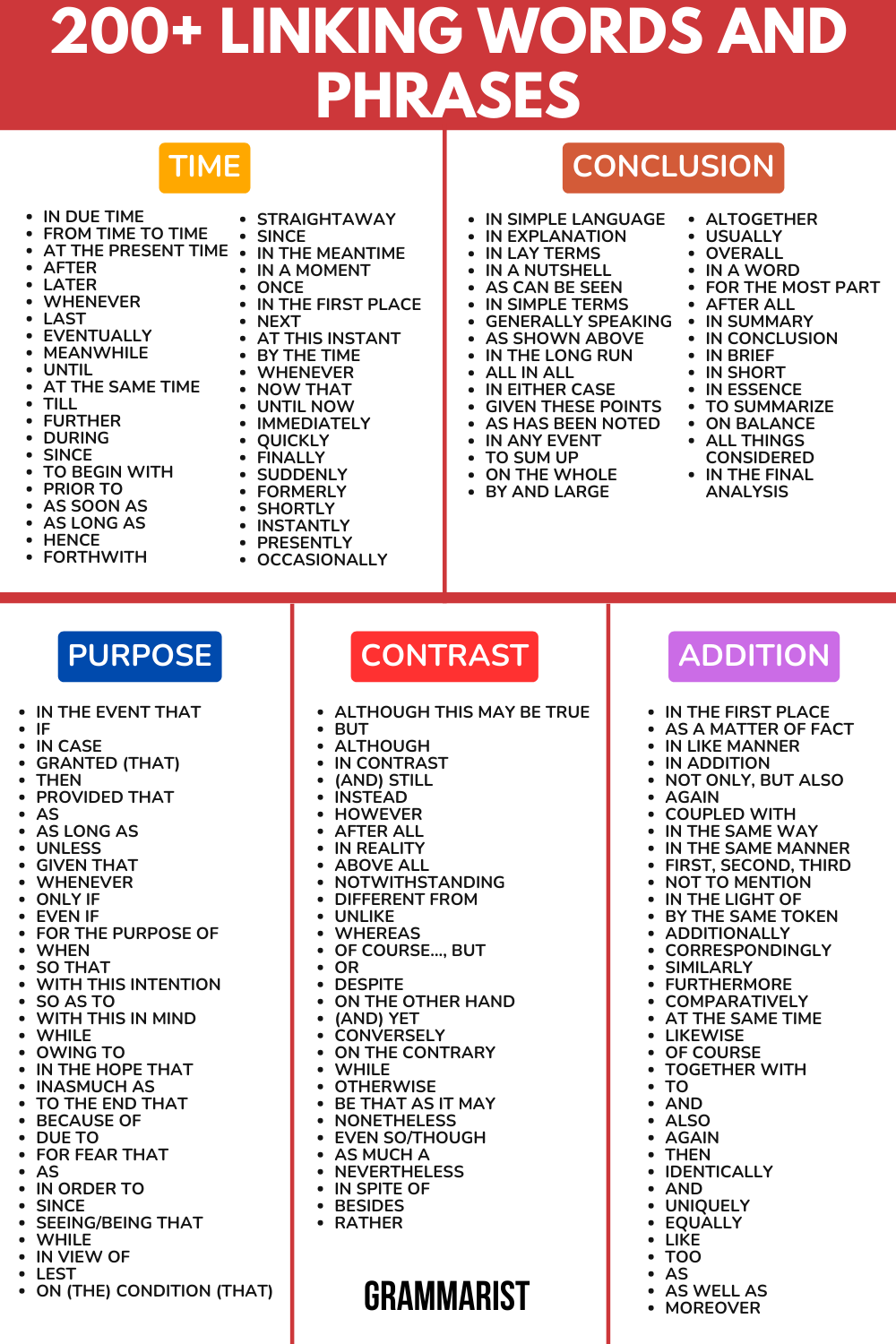
Now that you know the meaning of transition words, let’s look at the usage of transition words in sentences and clauses. Don’t worry, I’ll break it all down for you!
Below, I’ve got a list of linking words and phrases to serve as alternative choices for connecting ideas in writing. Note that there are several types of transition words which we will discuss later.
Agreement/Addition/Similarity
Linking words may help the reader understand additional comments or ideas in a statement. They may also express agreement or similarities. These words are also called additive transition words, commonly found in expository essays and narrative essays.
- In the first place
- As a matter of fact
- In like manner
- In addition
- Not only, but also
- Coupled with
- In the same way
- In the same manner
- First, second, third
- Not to mention
- In the light of
- By the same token
- Additionally
- Correspondingly
- Furthermore
- Comparatively
- At the same time
- Together with
- Identically
Here are some examples of additive linking words in a sentence.
- The group found that a constructivist approach leads to higher test scores. Moreover, essay examinations show higher levels of learning.
- The resort has tennis courts. Furthermore, it has an Olympic pool.
Negative Ideas
Some linking words come in pairs to join negative ideas.
- Not, neither
- Neither, nor
Here are sentence examples of linking words showing negative ideas.
- I haven’t seen Lory, neither have I talked to her friend.
- I neither drink nor smoke.
Opposition/Limitation/Contradiction
Whereas some linking words show an extra idea, these transition phrases and words express contrasting ideas in writing.
- Although this may be true
- In contrast
- (and) still
- Notwithstanding
- Different from
- Of course…, but
- On the other hand
- On the contrary
- Be that as it may
- Nonetheless
- Even so/though
- Nevertheless
- In spite of
Here are some sentences with linking words of opposition.
- The short story can be analyzed using a functionalist lens. However, its historical theme is better understood with a critical perspective.
- As much as I want to go, I must take care of my sister.
Some linking words show relationships between ideas by accepting an idea with reservation instead of showing complete opposition. Here are some examples.
- All the same
- Regardless of this
- Up to a point
Here are some sentence examples.
- Many citizens opposed this unfair policy, which the president nevertheless enacted.
- I like him even if we have different views in life.
Cause/Condition/Purpose
You may also use linking words in your writing piece to show conditions and purpose for a logical flow of ideas. Words like reason get the reader ready to understand why. These words are commonly found in hypothesis essays.
- In the event that
- Granted (that)
- Provided that
- On (the) condition (that)
- For the purpose of
- With this intention
- With this in mind
- In the hope that
- Inasmuch as
- To the end that
- For fear that
- In order to
- Seeing/being that
- The researchers used this method so that the results would be valid, reliable, and aligned with the objectives.
- I will not be attending the seminar due to a high fever.
Examples/Support/Emphasis
You can also use transition words in your piece of writing that show examples or support of an idea.
- In other words
- To put it differently
- For one thing
- In particular
- As an illustration
- In this case
- For example
- For instance
- For this reason
- To put it another way
- To demonstrate
- That is to say
- With attention to
- By all means
- To emphasize
- To enumerate
- Particularly
- Significantly
- Specifically
- Surprisingly
- Important to realize
- Another key point
- On the negative side
- First thing to remember
- Must be remembered
- To point out
- Point often overlooked
- She visited several cities, namely Portland, Jacksonville, Charleston, and Hartford.
- Transition words improve writing flow. For instance, we use further to add extra ideas related to the previous statement.
Effect/Consequence/Result
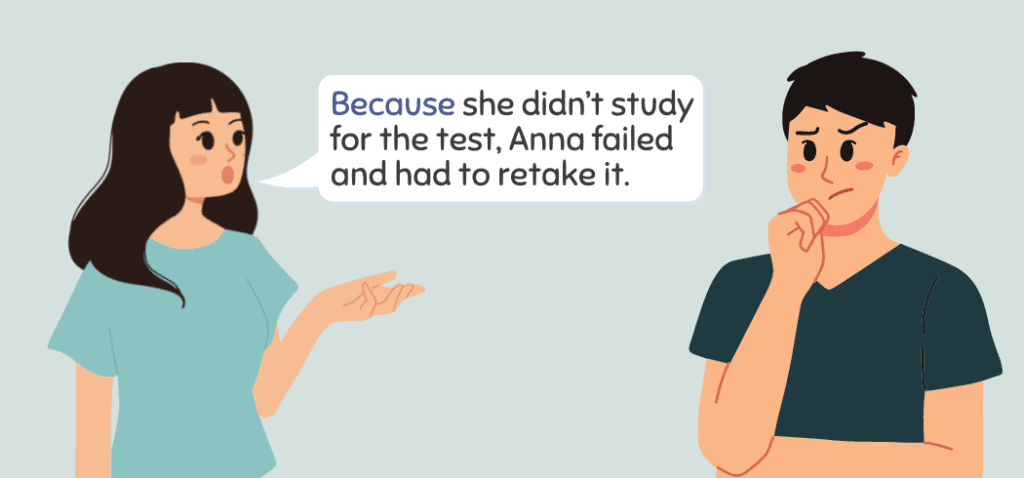
You might also spot transitional devices for essays that show consequences, results, and effects.
- As a result
- In that case
- Under those circumstances
- Accordingly
- Consequently
Consider the examples below.
- We watered the plant for seven days. In effect, it grew three inches taller.
- Because she didn’t study for the test, Anna failed and had to retake it.
Conclusion/Summary/Restatement
These words and phrases show transitions between sentences to show conclusions. You’ll find these words in essay conclusions of different essay types.
- In simple language
- In explanation
- In lay terms
- In a nutshell
- As can be seen
- In simple terms
- Generally speaking
- All things considered
- As shown above
- In the final analysis
- In the long run
- In either case
- Given these points
- As has been noted
- In any event
- On the whole
- By and large
- For the most part
- In conclusion
- To summarize
Note that in lay terms and in explanation are formal alternative choices to “ in a nutshell.”
Here are some examples.
- Matter is a material that occupies space and has mass. In simple language, it is any physical substance.
- I don’t want to climb the corporate ladder. After all, money isn’t everything.
Time/Chronology/Sequence
Linking words’ other role in writing is to show sequence or chronology. Under the time category, these phrases add a meaning of time. You can find these words in an essay introduction when the writer explains how the paper is structured.
- In due time
- From time to time
- At the present time
- Sooner or later
- Up to the present time
- To begin with
- Straightaway
- In the meantime
- In a moment
- Without delay
- All of a sudden
- At this instant
- First, second
- By the time
- Immediately
- Occasionally
- I watched the movie on television. Eventually, I fell asleep.
- First, fill the pan with water. Then, bring it to a boil.
Space/Location/Place
The following transition words are famous adverbial expressions that limit or modify space. Some of these words and phrases are also transition words of time.
- In the middle of
- To the left/right
- In front of
- On this side
- In the distance
- In the foreground
- In the background
- In the center of
- Adjacent to
- Opposite to
Below are sentence examples using transition words of space.
- My house is located behind the building.
- To the left of the supermarket is a flower shop.
Common Mistakes With Transition Words
Transition words help you create a flow of arguments for readers to understand what you’re saying. But misused transition words and phrases will make your writing unclear. Avoid these mistakes to give your readers a better experience.
Starting a Sentence With So, And, and Also
Both so and and are coordinating conjunctions, which means they can start independent clauses that stand on their own. But it’s not recommended to use these words and also as sentence starters in formal writing. For example:
- Incorrect: Also, there are unauthorized charges on my credit card account.
- Correct: Furthermore, there are unauthorized charges on my credit card account.
Combination of Transition Words And/Or
When writing an essay, avoid English transition words and/or because it makes your paper look messy. Instead, consider whether you need both connectors or only one of them. If you need them both, try this alternative.
- Incorrect: boat and/or plane.
- Correct: boat, plane, or both.
Using As Well As as Alternative to And
As well as has a different meaning from the transition word and. And means you’re listing something of equal importance. Meanwhile, as well as is for additional, less essential information. Here’s an example.
- Incorrect: In this paper, I discuss my movie analysis as well as provide recommendations for improvement.
- Correct: In this paper, I discuss my movie analysis and provide recommendations for improvement.
Archaic Words
Your writing may not make any sense to readers if you overuse archaic transition words like therewith .
For example, hereby means as a result. We can replace it with more modern and explicit phrasing expressing how the current statement is connected to the previous statement.
Linking Words Summary
A linking word is a term that connects different ideas in your text, whether they are contrasting, supporting, or adding. They can improve your writing and help it flow better, I promise!
Regardless of the style of writing, every piece of writing contains linking words to show perfect transitions. I hope my guide on the definition and list of transitions helps you use these words and phrases correctly. Memorize each category, and don’t overuse them in essays.
Grammarist is a participant in the Amazon Services LLC Associates Program, an affiliate advertising program designed to provide a means for sites to earn advertising fees by advertising and linking to Amazon.com. When you buy via the links on our site, we may earn an affiliate commission at no cost to you.
2024 © Grammarist, a Found First Marketing company. All rights reserved.
75 linking words for academic writing (+examples)
Linking words play an important role in academic writing: They connect different paragraphs, sections or ideas in a text. Therefore, they considerably improve the readability and argumentation of academic texts such as a thesis, dissertation, essay or journal publication. This list of 75 linking words includes examples of how they can be used in academic writing.
Disclosure: This post may contain affiliate links, which means I may earn a small commission if you make a purchase using the links below at no additional cost to you . I only recommend products or services that I truly believe can benefit my audience. As always, my opinions are my own.
Linking words expressing order and sequence in academic writing
Linking words expressing additions in academic writing, linking words expressing cause and effect in academic writing, linking words expressing contrasts and comparisons in academic writing, linking words expressing emphasis in academic writing, linking words expressing illustrations in academic writing, linking words expressing summaries and conclusions in academic writing, linking words expressing conditionality in academic writing, linking words expressing generalisations in academic writing, linking words expressing concessions in academic writing.
1. First(ly), second(ly), third(ly)
Example: First, I review the existing literature on cross-border collaboration. Second, I explain the methodology …
Example: The thesis starts with a literature review. Next, I describe the case study design.
Example: Finally, recommendations for future research are presented.
4. Subsequently
Example: Study participants underwent several experiments and were subsequently examined.
5. Afterwards
Example: The event increased public awareness of this issue. Afterwards, politicians debated it more openly.
6. Eventually
Example: Eventually, this led to the creation of a social movement.
Example: Before scientists discovered the role of neurons in information processing, they assumed that…
8. Previously
Example: Previously, scholars believed that nurture was the most important factor in a child’s development.

Example: Scholars examine the causes and effects of poverty.
10. Furthermore
Example: Furthermore, the data illustrates the number of chemicals that can be found in drinking water.
11. Additionally
Example: Additionally, the interviewee lamented a lack of attention to his work.
12. As well as
Example: Scholars utilise qualitative as well as quantitative methods to study this phenomenon.
13. Besides
Example: Besides the public outreach component, we wrote a handbook to disseminate the research results in the academic community.
Example: The financial compensation was also appreciated by the study participants.
15. Moreover
Example: Moreover, interviewees were asked to describe their own experiences.
You may also like: How to paraphrase a quote: 4 simple strategies
16. Because
Example: This theory was ultimately rejected because it was built on a flawed dataset.
Example: The outcomes improved since different parties joined forces.
Example: As the number of studies increases, better conclusions can be drawn.
Example: Scientists realised that the data analysis had flaws. So they decided not to run the same data analysis again.
20. Therefore
Example: Many researchers have conducted this experiment with similar results. Therefore, this theory can be debunked.
21. Consequently
Example: The literature highlights the importance of age and physical fitness. Consequently, these factors will be investigated further.
Example: Due to a low response rate, the study’s validity is low.
23. Nevertheless
Example: One academic study found the opposite results. Nevertheless, it can be argued that…
Example: Many scholars have explored this issue. Yet, to date, no inclusive framework exists to explain…
25. Although
Example: Although a confidentiality agreement was provided, study participants were hesitant to disclose private information.
26. In spite of
Example: In spite of the different study contexts, all experiments pointed to similar results.
27. Whereas
Example: People often stated that they are aware of the rules whereas they behaved as if they did not.
Example: While older studies often emphasise structural effects, newer ones tend to highlight the role of agency.
29. In contrast
Example: In contrast to previous findings, my analysis shows that…
30. Similarly
Example: One study found that the majority of residents in disadvantaged areas do not have access to sufficient resources. Similarly, my research revealed that most residents live too far away from the services and resources they would need to climb the social ladder.
31. Equally
Example: E qually important, however, is the role of personal beliefs in decision-making processes.
32. Likewise
Example: The interviewee considered this issue important and expected his colleagues to do likewise.
33. On the other hand
Example: On the one hand, research in this field advanced considerably in the last 20 years. On the other hand, a lot remains unclear.
Example: Unlike social scientists, physical scientists often conduct laboratory examinations.

If you are looking to elevate your writing and editing skills, I highly recommend enrolling in the course “ Good with Words: Writing and Editing Specialization “, which is a 4 course series offered by the University of Michigan. This comprehensive program is conveniently available as an online course on Coursera, allowing you to learn at your own pace. Plus, upon successful completion, you’ll have the opportunity to earn a valuable certificate to showcase your newfound expertise!
35. Particularly
Example: Particularly relevant for this study is the molecular orbital theory.
36. Especially
Example: Especially younger interviewees expressed dissatisfaction with the status quo.
37. Above all
Example: Above all, this method can generate better insights into the physical processes at hand.
Example: Indeed, motivation turned out to be a defining factor of academic success.
38. Clearly
Example: Clearly, these scholars were not aware of recent advances in medical sciences.
39. Definitely
Example: This was definitely the most important event of the year.
40. Importantly
Example: More importantly, the findings underscore the importance of conflict resolution.
41. Undoubtedly
Example: Undoubtedly, all stakeholders had good intentions.
42. Obviously
Example: Obviously it is too early to draw final conclusions.
43. Of course
Example: Of course, this study should be replicated in a different context.
44. Surprisingly
Example: Surprisingly, all results were unambiguous.
45. Such as
Example: Scientists have explored different parts of the problem, such as CO2 emissions and hydrological processes.
46. For example
Example: Many interviewees were nervous. For example, when asked to describe the event, some of them started to stutter.
47. For instance
Example: Scholars have criticised this approach for different reasons. For instance, they argued that qualitative methods are insufficient to draw generalisable conclusions.
48. In this case
Example: Difficulties arise when no study participants can be found. In this case, alternative methods should be considered.
50. To conclude
Example: To conclude, the empirical analysis supports previous research findings.
51. In conclusion
Example: In conclusion, the reviewed literature highlights a clear research gap.
52. To sum up
Example: To sum up, a mixed methods approach is a better choice than a purely quantitative one.
53. In summary
Example: In summary, it is my opinion that conditions should be improved.
54. In short
Example: In short, scholars call for more research on climate change mitigation.
55. Altogether
Example: Altogether, these examples support the main argument.
Example: Energy supply became a growing problem. Thus, new policies were implemented.
Example: The first dataset was incomplete. Hence, a new dataset had to be developed.
Example: Unless stated otherwise, I refer to the concept as…
59. As long as
Example: As long as the conditions do not change, the results should remain stable.
Example: If scientists study this phenomenon in the future, they should pay attention to structural drivers.
61. Provided that
Example: Provided that nothing changes, the effects on society will be negative.
Example: Should the distribution change, it is fair to expect…
63. Even if
Example: Even if more experiments are conducted, human behaviour remains hard to predict.
Example: Often, this issue was flagged by interviewees themselves.
65. Commonly
Example: Commonly, this criterion is used for categorising plants.
66. Overall
Example: Overall the data confirmed the hypothesis.
67. Typically
Example: Typically emotions run high in such situations.
68. Generally
Example: Generally speaking, scholars address this issue from two angles.
Example: Mainly researchers in the global North discuss this phenomenon.
Example: Mostly, these results cannot be replicated outside of the lab.
71. Even if
Example: This is hard to prove. Even if the study sample is large enough.
72. Regardless of
Example: Regardless of their genetic makeup, mice showcased the same symptoms.
Example: Albeit experiencing setbacks, successful students do not get discouraged.
74. Admittedly
Example: Admittedly, the validity of this study should be increased.
75. Nonetheless
Example: Nonetheless, this study can be seen as a valuable contribution to the international literature.
Master Academia
Get new content delivered directly to your inbox.
Subscribe and receive Master Academia's quarterly newsletter.
How to paraphrase a quote: 4 simple strategies
The best coursera courses for phd researchers in 2023, related articles.

How to organize and structure academic panel discussions

How to prepare your viva opening speech

37 creative ways to get motivation to study

The top 10 thesis defense questions (+ how to prepare strong answers)

- TEFL Internship
- TEFL Masters
- Find a TEFL Course
- Special Offers
- Course Providers
- Teach English Abroad
- Find a TEFL Job
- About DoTEFL
- Our Mission
- How DoTEFL Works
Forgotten Password

- Linking Words & Connector Words: Ultimate List With Examples
- Learn English
- James Prior
- No Comments
- Updated February 23, 2024

Linking words and connector words are essential tools for effective communication and writing. They play a crucial role in connecting ideas, enhancing coherence, and guiding the flow of information. Whether you’re writing an essay, giving a presentation, or engaging in a conversation, using appropriate linking words can greatly improve the clarity and effectiveness of your message.
In this ultimate list of linking words, we have compiled a comprehensive collection of linking words along with examples to help you understand their usage and apply them in various contexts. From words that highlight contrast and similarity to those that indicate cause and effect or order of importance, this list covers a wide range of linking words to suit different purposes.
Ready to link your words? Let’s get started!
Table of Contents
What are linking words?
Linking words, also known as connector words or transition words, are words or phrases that connect ideas or parts of a text, providing coherence and smoothness to the overall flow of information. They serve as bridges between sentences, paragraphs, or even larger sections of a document, helping to establish relationships, indicate contrasts, add information, show cause and effect, provide examples, and more.
Here are some common categories of linking words with examples:
Linking words for addition
Addition: Words that show the addition of information or ideas.
These linking words and phrases can help you add information, reinforce ideas, or provide further examples in your writing or conversation. Use them appropriately to expand on your points and enhance the overall coherence and richness of your communication.
- She is fluent in English, and additionally, she speaks French and Spanish.
- The report highlights the benefits of renewable energy; furthermore, it emphasizes the importance of conservation.
- The new system not only improves efficiency but moreover, it reduces costs.
- In addition to his regular job, he volunteers at a local charity.
- She not only excels in academics but also actively participates in extracurricular activities.
- The team consists of experienced professionals as well as enthusiastic newcomers.
- The company values teamwork; likewise, it fosters individual growth and development.
- Besides working full-time, he manages to pursue his hobbies and spend time with famil
- The website offers free shipping; what’s more, customers can enjoy a 30-day money-back guarantee.
- On top of their regular duties, employees are encouraged to take part in professional development opportunities.
- Developing strong interpersonal skills is equally important as acquiring technical knowledge.
- The event attracted a large audience, not to mention the media coverage it received.
- Along with the new software update, customers will also receive enhanced customer support.
- The company achieved its sales targets for the year; what is more, it surpassed them by 20%.
- The team completed the project ahead of schedule; besides that, they received positive feedback from the client.
- The company’s commitment to quality, coupled with its competitive pricing, sets it apart from its competitors.
Linking words for contrast
Contrast: Words that highlight differences or contrasting ideas.
These linking words and phrases can help you express contrasting ideas and show the differences between two or more concepts or situations. Remember to use them appropriately based on the context and your intended meaning.
- She studied hard; however, she didn’t pass the exam.
- John loves traveling; on the other hand, his sister prefers staying at home.
- The weather was terrible; nevertheless, they decided to go for a walk.
- He had a sprained ankle; nonetheless, he played in the soccer match.
- Despite the rain, they went to the beach.
- In spite of the traffic, they arrived on time.
- Although it was late, they continued with their work.
- Even though she was tired, she went to the gym.
- I enjoy reading, while my brother prefers watching movies.
- Sarah loves cooking, whereas her husband prefers eating out.
- Unlike his friends, Mark is not a fan of horror movies.
- She hates winter; conversely, I love it.
- She expected him to be upset; on the contrary, he was happy.
- They planned to go to the cinema, but instead, they stayed home and watched a movie.
- The cat is small and playful, in contrast to the dog, which is big and lazy.
- He enjoys sports; conversely, his sister prefers art.
- On one hand, the book is interesting; on the other hand, it’s quite lengthy.
- They could go by car, or alternatively, they could take the train.
- The movie received mixed reviews; nevertheless, it became a box office hit.
- She didn’t pass the test, but in any case, she learned a lot from studying.
Linking words for similarity
Similarity: Words that highlight similarities or shared ideas.
These linking words and phrases can help you express similarities between two or more ideas, situations, or individuals. Use them appropriately based on the context to highlight shared characteristics or experiences.
- Sarah enjoys reading; likewise, her brother is an avid reader.
- John and Emily both love hiking; similarly, they enjoy spending time in nature.
- Just as Sarah likes swimming, in the same way, her best friend enjoys diving.
- Jack has a passion for photography, similarly to his sister who is also an enthusiast.
- Just like her mother, Jane has a talent for playing the piano.
- The two artists approach their work in a similar vein, both using vibrant colors and bold brushstrokes.
- Mark loves cooking, and by the same token, he also enjoys experimenting with new recipes.
- As the workload increased, the stress levels of the employees correspondingly rose.
- Both Sarah and Emily are equally skilled in playing the guitar.
- The designer creates unique clothing pieces, and in a similar fashion, the jewelry maker crafts one-of-a-kind accessories.
- Just as the sun rises in the morning, the moon appears in the evening.
- The teacher explains complex concepts in a simple and understandable way, in the same manner as her colleague.
- He enjoys hiking and camping, and his friends, likewise, too, share his enthusiasm for outdoor activities.
- Just as a bird builds its nest with care and precision, in the same way, an architect plans and constructs a building.
- The two books explore themes of love and loss, along similar lines, inviting readers to contemplate the human experience.
- As with all great artists, Picasso’s work continues to inspire and influence generations.
- Exercise is essential for physical health, and just as importantly, it is crucial for mental well-being.
- Much like a puzzle, life consists of various pieces that fit together to form a bigger picture.
Linking words for cause and effect
Cause and Effect: Words that demonstrate cause and effect relationships.
These linking words and phrases can help you express the cause-and-effect relationship between events or actions. Use them appropriately based on the context to convey the reason and result of a particular situation or occurrence.
- He failed the exam because he didn’t study.
- They arrived early since they left home on time.
- As a result of heavy rainfall, the streets were flooded.
- The event was canceled due to bad weather conditions.
- The store was closed, therefore, they had to find another place to shop.
- He missed the train, consequently, he arrived late to the meeting.
- Owing to a power outage, the concert was postponed.
- She didn’t have enough sleep, thus, she felt tired throughout the day.
- He couldn’t attend the party, for this reason, he sent his apologies.
- The storm caused damage to the houses, resulting in the need for repairs.
- The baby was hungry, so she started crying.
- Lack of exercise and poor diet often leads to weight gain.
- They missed the train because of heavy traffic.
- The roads were icy, this is why there were many accidents.
- They spent all their money, as a consequence, they couldn’t afford the trip.
- He quit smoking, and since then, he feels healthier.
- The company introduced a new product, and in turn, its sales increased.
- She studied hard so that she could pass the exam.
Linking words for time and sequence
Time and sequence: Words that indicate time or sequence of events or actions.
These linking words and phrases can help you express the chronological order and sequence of events or actions. Use them appropriately to guide your audience through the progression of ideas or to outline the steps in a process or narrative.
- Firstly, let’s discuss the main causes of climate change.
- Secondly, we need to consider the potential solutions to the problem.
- Next, we will move on to the implementation phase of the project.
- We need to complete the research phase first. Then, we can start analyzing the data.
- After that, we can proceed with the construction of the building.
- The company experienced financial difficulties. Subsequently, they had to lay off several employees.
- The team was working on the project. Meanwhile, the marketing department was preparing the promotional materials.
- The two processes are happening simultaneously, ensuring efficient production.
- The report will be ready in a week. In the meantime, please proceed with the other tasks.
- During the meeting, we will discuss the budget and timeline.
- While he was studying, his friends were playing video games.
- Please wait here until your name is called.
- We need to complete the paperwork before the deadline.
- She attended the conference, and afterward, she shared her insights with the team.
- Finally, we reached an agreement after a long negotiation process.
- In the end, they decided to cancel the project due to budget constraints.
- The presentation was engaging, and at the same time, informative.
- Initially, he struggled with the new software, but with practice, he became proficient.
- At first, the project seemed overwhelming, but with proper planning, it became manageable.
Linking words for order of importance
Order of Importance: Words that highlight the hierarchy or ranking of ideas based on their significance.
These linking words and phrases can help you establish the order of importance when presenting ideas or arguments. Use them to emphasize the significance of certain points, highlight key considerations, or guide the reader’s attention to the most critical aspects.
- Most importantly, we need to prioritize the safety of our employees.
- Above all, we must prioritize the needs of our customers.
- The company’s success primarily depends on effective leadership and strategic planning.
- First and foremost, we need to address the urgent issue of inflation.
- The new policy chiefly focuses on reducing waste and promoting sustainability.
- Notably, the project resulted in significant cost savings for the organization.
- Above anything else, maintaining a high standard of quality is our top priority.
- It is essential to note that effective communication is the foundation of strong relationships.
- It is worth mentioning that the company’s ethical practices have earned it a positive reputation.
Linking words for exemplification
Example: Words that provide examples or illustrate a point.
These linking words and phrases can help you introduce examples and provide further clarification or evidence to support your statements. Use them to enhance your explanations and illustrate your points effectively.
Here’s a list of linking words and phrases that are commonly used to illustrate an example, along with examples:
- There are many fruits you can choose from, for example, apples, oranges, and bananas.
- Many countries have implemented environmental policies; for instance, Sweden has significantly reduced its carbon emissions.
- I enjoy outdoor activities such as hiking, cycling, and swimming.
- The party was attended by several guests, including friends, family, and colleagues.
- He has many hobbies, like painting, playing the guitar, and photography.
- The company provides various employee benefits, as an illustration, health insurance, retirement plans, and paid time off.
- Let me give you an example to illustrate my point.
- There are several endangered species in the area, namely the African elephant, the Bengal tiger, and the giant panda.
- The city offers various attractions, in particular, museums, parks, and historical landmarks.
- The project requires specific skills, specifically programming and data analysis.
- By way of example, let’s consider the case of a successful startup that disrupted the market.
- To give an example, let’s say you want to improve your fitness; you can try activities like jogging, swimming, or joining a gym.
- The experiment was conducted to demonstrate the effects of temperature on plant growth.
- As a case in point, many countries have implemented renewable energy initiatives to combat pollution.
- I will use a specific scenario to exemplify how the new policy can be implemented effectively.
- The job requires strong communication skills , in essence, the ability to express ideas clearly and persuasively.
- The city has invested in renewable energy projects to reduce its carbon footprint. One example of this is the installation of solar panels on public buildings.
- To be specific, the company offers three main product lines: electronics, appliances, and furniture.
- The data collected serves as proof that the new marketing strategy is effective.
- In a similar manner, many companies have embraced remote work as a response to the pandemic.
Linking words for focusing
These linking words and phrases can help you direct attention or emphasize a specific aspect of your discussion or argument. Use them appropriately to highlight the main points or focus areas, ensuring clarity and precision in your communication.
Here’s a list of linking words and phrases that are commonly used to express focusing or directing attention, along with examples:
- Specifically, we need to address the issue of employee turnover in our department.
- The marketing team has made significant progress, particularly in digital advertising.
- In particular, we need to improve our customer service to enhance customer satisfaction.
- Notably, the company achieved a record-breaking sales figure in the last quarter.
- This task requires attention to detail, especially when dealing with sensitive data.
- Specifically speaking, the new software update addresses the security vulnerabilities.
- Above all, we must prioritize the safety of our employees.
- The company’s success mainly relies on customer satisfaction and brand reputation.
- The primary goal of our project is to reduce waste and promote sustainability.
- Essentially, our focus should be on optimizing operational efficiency.
- Individually, each team member plays a crucial role in achieving our objectives.
- Precisely, we need to adhere to the project timeline to meet the deadline.
- Specifically, with regards to customer feedback, we have received positive reviews.
- The new product line has a sleek design, not to mention its advanced features.
- It is worth noting that the market trends are shifting towards online shopping.
- Above everything else, we need to prioritize the quality of our products.
- In essence, our primary objective is to provide exceptional customer service.
- To be more precise, we should focus on improving our supply chain management.
- In specific terms, the sales team needs to focus on building client relationships.
- More importantly, we need to address the concerns raised by our customers.
Linking words for conclusion
Conclusion: Words that summarize or conclude a text.
These linking words and phrases can help you signal the conclusion of your argument, presentation, or essay. Use them to summarize key points, restate your main argument, or provide a final thought or recommendation.
- In conclusion, it is evident that deforestation poses a significant threat to our planet.
- To sum up, the project was a great success, exceeding all expectations.
- Ultimately, the decision lies in your hands.
- All in all, it was a memorable vacation filled with adventure and relaxation.
- Lastly, I would like to thank everyone for their hard work and dedication.
- In summary, the findings of the study suggest a strong correlation between exercise and mental well-being.
- To conclude, the evidence supports the hypothesis that regular exercise improves cardiovascular health.
- The data collected consistently points to the same conclusion; therefore, we can confidently assert our findings.
- In essence, the research demonstrates that social media has a profound impact on interpersonal relationships.
- The campaign received widespread support, and as a result, donations increased significantly.
- In a nutshell, the project aims to promote sustainability through renewable energy initiatives.
- The experiments consistently yielded similar results; thus, we can draw a definitive conclusion.
- The evidence strongly suggests a link between smoking and lung cancer; hence, it is crucial to raise awareness about the risks.
- In light of these findings, it is necessary to reconsider the current educational policies.
- The company faced financial challenges, and consequently, had to downsize its workforce.
- In conclusion, it can be stated that effective communication is the key to successful teamwork.
- Taking all factors into account, it is clear that globalization has both positive and negative consequences.
- The lack of investment resulted in decreased productivity, as a consequence, the company experienced a decline in profits.
- The study findings reveal a correlation between stress levels and sleep quality; thus, it can be inferred that managing stress positively affects sleep.
- Given these points, it is evident that the project should be prioritized for its long-term benefits.
If you’d like more examples, check out this list of other ways to say in conclusion .
Conclusion: Ready to link your words?
These are just some examples of linking words, and there are numerous other linking words and phrases available for different purposes and contexts. Using them appropriately can greatly enhance the clarity and coherence of your writing or speech. So, if you want to become more fluent in English, it’s time to start thinking about linking words!
- Recent Posts
- 27 Christmas Idioms With Their Meanings & Examples - November 4, 2024
- 25 Fun Christmas Classroom Activities for Your Class - November 4, 2024
- Bear With Me or Bare With Me: Which is Correct? - November 1, 2024
More from DoTEFL

Welcome Aboard vs Welcome On Board – What’s the Difference?
- Updated February 13, 2024

Countries or Countrys or Country’s: What Is the Plural of Country?
- Updated September 27, 2023

15 Things I Wish I Knew Before Teaching English in China
- Kaitlin Silverman
- Updated November 2, 2023

Bests or Best? How to Correctly Sign Off an Email
- Updated February 19, 2023

What Is TEFL & Is It Right For You?
- Updated February 2, 2024

17 Types of Essays: Examples and Quick Guide
- Updated November 9, 2024
- The global TEFL course directory.
- Academic writing
- Commonly confused words
- Critical thinking
- PEEL Paragraphs
- Linking/transition words
- Paraphrasing
- Proofreading
- Terms and definitions
- Action Words: What is description, application, analysis and evaluation
Linking/transition words: Things you need to know...
All assignments are written in formal language. You need to ensure that you demonstrate your knowledge and understanding alongside your ability to answer the question/solve the problem.
Below are some ideas to help you to develop your structure and flow.
- Linking / transition words and phrases join ideas, sentences and paragraphs together. They should be used within sentences and to move from one idea to another (between sentences).
These words and phrases indicate the direction, order and flow of ideas. Significantly, they strengthen the quality and structure of your work.
- Redundant Words - less is more. P articularly when trying to reduce the word count, it is important to look for phrases which can be replaced with a single word.
Linking/Transition Words
Transitions link one main idea to another separated by a semi-colon or full-stop. When the transition word is at the beginning of the sentence, it should be followed by a comma:
Among other functions, they can signal cause and effect or sequencing (see examples in the table below).
Linking words: conjunctions
Linking words within a sentence are referred to as coordinating conjunctions. Do not worry about the term: think about the function.
Conciseness / redundant words
Microsoft Word now has an additional feature within the Edito r - it is called conciseness or wordiness.
- If you cannot see the Editor menu a quick tip is to hold down the function (fn key at the bottom left of the keyboard) + F7 (top line of keys).
- From the Refinements section - select Conciseness - if there are any suggestions a number will appear in the box alongside this option
- A dotted line will appear under any groups of groups
- Either select the identified text by clicking with your right mouse button OR click on the down down next to the Conciseness menu.
- MS Word will display any alternative words which you can either select and they will be replaced in your text or reject if you want to keep the original phrases.
Examples: try to replace phrases with a single words which mean the same.

Need to know more...
- Related pages
- External links
- Academic writing Illustrates the main features of academic writing so that you are aware of what it is and what it involves
- Critical Thinking Academic work involves thinking, not just accepting what you read or are told.
- Terms and Definitions Important words appear in your assignments and examinations. The aim of this factsheet is to help you to fully understand what they mean.
Additional resources to help you to improve your confidence and grades:-
- Writing Effectively demonstrates the importance of: clarity, structure, relevance, argument and precision.
- Writing Mechanics gives further examples and resources on areas including: sentence structure, vocabulary, spelling, punctuation and grammar.
Linking/Transition words - Scribbr https://www.scribbr.co.uk/syntax/transition-words-examples/ [Accessed 10 February 2023]
There are many books concerning academic writing, look around Dewey number 808
- << Previous: PEEL Paragraphs
- Next: Paraphrasing >>
- Last Updated: Nov 8, 2024 10:38 AM
- URL: https://libguides.staffs.ac.uk/academic_writing
- Library and Learning Services, University of Staffordshire, College Road, Stoke-on-Trent, ST4 2DE
- Accessibility
- Library Regulations
- Appointments
- Library Search


Linking Words, Connecting Words: Full List and Useful Examples
Linking words (connecting words) are something we need to know in any style of writing, because it helps the reader to follow the flow of what you are saying. Whether it’s an argument in an essay , or an epic scene in a fantasy novel, your reader needs to be able to follow what you are saying. So, what are linking words, why should you bother learning them, and what does it look like in practice? Well, this guide will answer all of those questions!
Linking Words

What Are Linking Words?
Linking words are words that connect ideas together in a piece of writing . It shows that two things are related in some way, or that the point you are making has supporting information. The difference between linking words and simple paragraph starters that we looked at previously, is that linking words can be found at the start of paragraphs, but also in the middle of sentences to connect two ideas together too.
Why Should I Learn Linking Words/Connecting Words?
The answer to this one is fairly straightforward. If you don’t know a variety of linking words to connect ideas together in a piece of writing, then you’re writing won’t make sense. In the very best case here, your reader will become confused and fail to follow the message you are trying to get across in your writing, because the bits of text that should ordinarily fit together, just won’t without the linking words there to connect them.
So, you know what they are and why you need to know them – but what are some examples of linking words? We couldn’t possibly include them all because there are literally hundreds, but hopefully by highlighting some examples and showing their importance in a sentence, you’ll be able to understand the job they do more clearly and focus on learning some other ones for yourself.
Examples of Linking Words
Linking words to add more information.
These words simply add additional information to your sentence or paragraph to show that two ideas are similar. Here are some examples:
- It started to rain and I got soaked – ‘and’ is the linking word that connects the two ideas of the individual being in the rain and getting soaked.
- It can’t be the dog’s fault nor the cat’s – ‘nor’ connects the idea that neither the cat or dog was at fault.
- We could go shopping first then get a bite to eat – ‘then’ shows that both ideas are connected, it also adds some sequence to the sentence by showing the order of things.
Linking Words to Contrast a Point
Sometimes you need to link two ideas together that are actually opposites in terms of what you are trying to say. Here are some words that will help you do that:
- Annie could have gone for a run but she decided she was too tired – ‘but’ connects two ideas that are related, but they oppose one another. She could have gone for a run, but she didn’t.
- It’s my turn to make dinner tonight although a takeout might be easier – ‘although’ provides an opposite argument again, so it links the ideas in a contrasting way.
- Carrots seemed to be the bunnies preferred food. On the other hand , lettuce was chosen second most frequently and the difference was marginal – ‘on the other hand’ shows clearly to the reader that a different point of view is coming.
Linking Words to Support a Point
If you’re trying to prove something or say something happened as a result of something else, then you will need words like the following:
- I failed my test because I didn’t study – ‘because’ gets the reader ready to learn why somebody failed their test.
- I could have done something differently, in fact we all could have – ‘in fact’ shows that the two ideas are linked together and support one another.
- Jack had been sad since his girlfriend broke up with him – ‘since’ is being used here to explain why Jack was sad, so it links the ideas again.
There are many more examples and reasons for using linking words, but if you do some more research into the different linking words that there are, you’ll be able to see how you might use them to connect two ideas together in some way. Remember, they don’t always need to support one another. Sometimes ideas are connected because they oppose one another too.
Learn more with an ultimate guide to transition words and phrases in the English language.
Complete List of Linking Words & Connecting Words
Linking words – result.
Function: To provide the result of what has been stated or has occurred
- Accordingly
- As a consequence (of)
- As a result
- Consequently
- For this reason
Connecting Words – Emphasis
Function: To put forward a point or idea more forcefully
- Importantly
- It should be noted
- Particularly / in particular
- Surprisingly
- To emphasize
- Undoubtedly
- Unquestionably
- With attention
- Without a doubt
Linking Words – Addition
Function: To add to what has been previously stated
- Additionally/an additional
- Apart from this
- As well as that
- Coupled with
- Furthermore
- In addition
- In addition to this
- In the same fashion
- Not only…but also
- Not to mention
- Together with
Linking Words – Reason
Function: To provide reasons for what has been stated or has occurred
- For the purpose of
- Granted that
- In order to
- Provided that
- Seeing that
- With this in mind
- With this intention
- With this purpose
Connecting Words – Illustration
Function: To provide examples
- As an example of
- For example/ For instance
- For one thing
- Illustrated by
- In another case
- In the case of
- In this case
- In this situation
- On this occasion
- Proof of this
- Specifically
- To demonstrate
- To demonstrate/ To clarify
- To simplify
Linking Words – Contrast
Function: To show how things are different
- Alternatively
- As opposed to
- Contrary to
- Despite/in spite of
- Differing from
- In contrast (to)
- In opposition
- Nevertheless
- Nonetheless
- Notwithstanding
- On the other hand
Linking Words – Comparison
Function: To show how things are similar
- By the same token
- Compare / compare(d) to (with)
- Correspondingly
- In a similar manner
- In like manner
- In the same way
- In the spitting image of
- Just as…so too
- Most important
- Still another
Connecting Words – Order
1. Function: To indicate the order of what is being said
- First/ firstly
- Second/ secondly
- Third/ thirdly
- At this time
- Subsequently
2. Function: To mark the end of an ascending order
- Lastly and most importantly
- Last but not least
3. Definition: To mark the beginning of a descending order
- First and foremost…
Connecting Words – Summary
Function: To sum up what has been previously stated
- All things considered
- As demonstrated above
- As shown above
- As you can see
- By and large
- Generally speaking
- Given these points
- In any event
- In conclusion
- In the final analysis
- On the whole
- To conclude
- To summarise
Linking Words – Condition
Function: To provide a condition to what has been stated
- Although this may be true
- In that case
- In the event that
- On the condition that
Connecting Words – Concession
Function: Connecting words and phrases to accept a point or idea with reservation
- All the same
- Although/Even though
- Be that as it may
- Even though
- In spite of
- Regardless of this
- Up to a point
Connecting Words – Generalisation
Function: To make a general statement
- Broadly speaking
- For the most part
- In general/ Generally
- In most cases
- More often than not
- Predominately
Connecting Words – Restatement
Function: To express an alternative to what has been previously stated
- Alternatively stated
- Expressed simply
- In a nutshell
- In other words
- In simple language
- In simple terms
- In summation
- Otherwise stated
- Put differently
- Put in another way
- Said differently
- That is to say
- To put it differently
Connecting Words – Reference
Function: To a relationship between continuing ideas presented in your essay.
- As applied to
- Considering
- In connection to
- Pertaining to
- Some examples of these might be:
- Speaking about/of
- The fact that
- With regards to
- With respect to
Connecting Words – Clarification
Function: To indicate that you will be exploring your ideas in more detail.
- In explanation
- In lay terms
- Simply stated
- To break it down
- To clearly define
- To make plain
- To put it clearly
- To put it in another way
Connecting Words – Space/ Location
Function: To clarify spatial relationships/ provide spatial order and reference.
- At the rear
- Surrounding
- To the left
Linking Words and Phrases | Video
Learn transition words video with American English pronunciation.
- Latest Posts
- 10 Rare Words for Expanding Your English Vocabulary - June 5, 2024
- What Does the Term “Hypocritical” Mean? - January 27, 2024
- SWAG Meaning: What Does it Mean? - January 25, 2024
Improve your writing with the help of AI writing assistants!

You are using an outdated browser. Please upgrade your browser to improve your experience.
The Ultimate List of Linking Words for Your Essay

Let’s face it: You can’t write an essay (or any other writing piece) without linking words.
Also known as connecting words or transition words, they serve to make your writing flow and help those reading your work follow the flow of your thoughts, ideas , and arguments .
This post is your guide to linking words and their role in writing. Not only will you learn the types of these words, examples, and reasons to use them, but you’ll also get a massive list of transition words and phrases as well as linking words PDF to download and use whenever necessary.
Table of Contents:
What are Linking Words?
Why use transition words in essays, linking words examples, addition/agreement/similarity, contrast/contradiction/limitation/opposition, comparison/concession/condition, clarification, cause/effect/result, emphasis/example, generalization, illustration, location/place/space, reason/reference, time/sequence, summary/conclusion/restatement.
- The Ultimate List of Linking Words: Download
Linking words are lexical items (words and phrases) we use to connect ideas in writing and get a reader to the next sentence or paragraph.
They aren’t about essay writing only:
Whether you write a fiction book, marketing content , academic works, autobiography , or poems, you’ll need to connect ideas. That’s what transition words do:
They link your thoughts and arguments into a chain to show how they relate to each other. Also known as transition words, these phrases often start a sentence or a paragraph. However, you’ll also use them in the middle of sentences to bring ideas together.
The most common places for linking words in essays are:
- the start of a paragraph
- the start of a sentence introducing a new idea or extending an argument
- the beginning of a concluding statement
Essay linking words is an integral part of academic writing. Put it simply, you can’t write a paper without using them; otherwise, your writing won’t make any sense for readers.
Transition words for essay serve to:
- connect ideas in writing
- create a flow of thoughts and arguments for readers to understand what you want to say
- guide readers from one idea to another, demonstrating how they relate to each other
- hook readers and encourage them to read the next sentence or paragraph
- add more information
- support or contrast a point
- show the result, conclude, demonstrate an effect of this or that point
Using essay maker and connecting words, each sentence and paragraph must pass readers on to the next one. These connecting words serve as an instrument to guide readers from one thought or point to the next.
Linking words examples are many, and it’s clear why: every piece of writing contains tons of connecting and transition words. Let’s take an essay sample from Bid4Papers writers to see the example of linking words in academic writing:
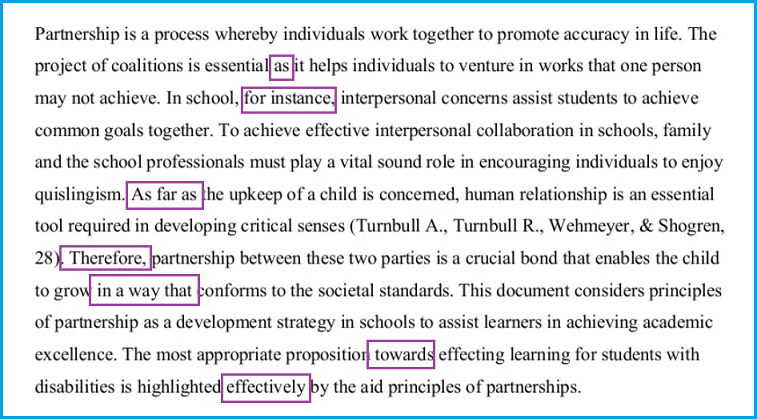
This one was an essay introduction .
Now, why not take a step further and look for essay linking words in essay conclusions ?
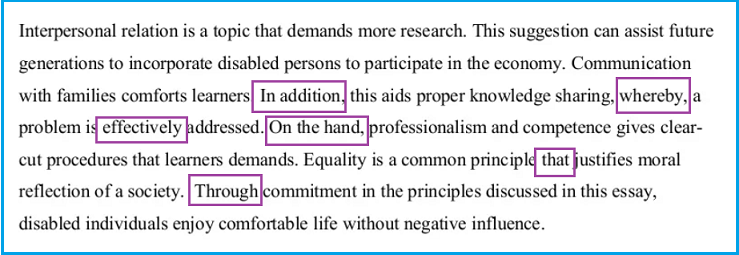
Types and List of Linking Words to Use in Essays
Below you’ll find the ultimate list of transition words for essays by categories. Choose the role you need a word to play (reason, contrast, emphasis, restatement, etc.) and consider the corresponding table of transitions.
If you need the whole transition words list in one place, jump to the next category of this post to find the downloadable linking words pdf.
And now, for connecting words categories:
These words serve to add info to what you’ve previously stated, demonstrate the commonality between arguments, and support your thoughts.
Linking words for contrast is your instrument to show how things are different and provide counterarguments. They work best in persuasive and critical essays.
These lexical items will help you if you need to provide conditions to your statements, show how things are different/similar, or accept a point with reservation.
These words will help you with personal or narrative essays: They are linking words in opinion writing that indicates you’re going to explore ideas in more detail.
Expository essays will win with these words too.
Cause and effect connecting words do what their name says exactly: demonstrating a cause of some point and providing the result of what has been done or started.
These words are for putting forward your point more forcefully, providing examples.
Perfect transition words for hypothesis essays , generalization lexical items serve to make a general statement you’ll then specify and prove in detail.
These words and phrases are for you to provide examples in essays.
Use these words to provide order and reference or clarify spatial relationships between your points or ideas.
These transitional words will help you demonstrate relationships between ideas and provide reasons for what and why has started or occurred.
Use these words in your essay when you need to indicate the time and order of what you say.
Restatement words will help you express an alternative to what you previously stated. They work for all essay types, including rhetorical precis and dialectic essays .
Use summary and conclusion transitional phrases to sum up your points and come up with the final paragraph of your writing.
The Ultimate List of Connecting Words: Download
And now, for the most interesting and practical part:
Below you can find the linking words worksheet that gathers all the most commonly used transitional words in essays. Feel free to download this linking words PDF and refer to it every time you write an essay and experience writer’s block:
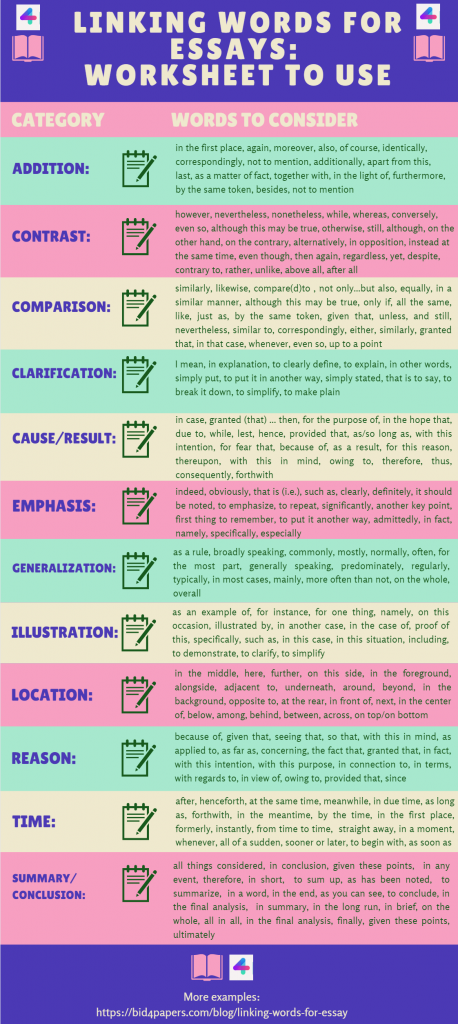
Do you need more guides and worksheets like this to assist you with academic writing? Please share your ideas in the comments, and our writers will be happy to help!
Related posts
- Harvard Referencing Style: A Comprehensive Guide
- What Is the Difference between Primary and Secondary Sources
- Common Types of Plagiarism with Examples
Our Writing Guides

Linking Words (Transitional Expressions)

Table of Contents
Introduction.
Linking words in English, also known as transition words or cohesive devices, are words or phrases that enhance the flow of a sentence or paragraph by indicating the relationship between ideas. In this article, we will cover examples of these transitional words to help write cohesively and coherently.
Let’s start by understanding what we mean by linking words!
What Are Linking Words?
Linking words, also referred to as transition words, connectives, or cohesive devices, play a crucial role in enhancing the structure and coherence of written and spoken English.
These words and phrases serve as bridges between ideas, helping readers or listeners navigate through the text or speech more smoothly. They establish logical relationships between different parts of a sentence, paragraph, or discourse, making the overall communication more organized and comprehensible.
Examples of linking words include words for addition (e.g., in addition, furthermore, etc.), for contrast (e.g., however, but, etc.), for cause and effect (e.g., because, since, etc.), for purpose (e.g., so that, in order to, etc.), and for summarizing (e.g., in summary, in a nutshell, etc.).
Why Are Linking Words Important?
Incorporating linking words within and between sentences and paragraphs enhances the logical flow of your writing. These words serve as valuable signposts, aiding your reader in navigating seamlessly from one idea to the next while elucidating the relationships between sentences or paragraphs.
A text without linking words lacks cohesion , thereby undermining the creation of a coherent overall meaning. Consider the following two texts: the first is equipped with linking words, and the second is without. Observe how the inclusion of linking words significantly contributes to the overall coherence of the text.
Paragraph 1 (With Linking Words):
In the bustling city, the streets were alive with activity. Moreover , the constant hum of traffic and the vibrant colors of city lights created a mesmerizing scene. Despite the urban hustle, a sense of harmony prevailed. Additionally , the aroma of street food wafted through the air, enticing passersby. However , beneath the surface of this dynamic cityscape, challenges lurked. The gap between the affluent and the underprivileged was evident. Nevertheless , efforts were being made to address social inequalities and foster a more inclusive community.
Paragraph 2 (Without Linking Words):
In the bustling city, the streets were alive with activity. The constant hum of traffic and the vibrant colors of city lights created a mesmerizing scene. You could observe an urban hustle. A sense of harmony prevailed. The aroma of street food wafted through the air, enticing passersby. Beneath the surface of this dynamic cityscape, challenges lurked. The gap between the affluent and the underprivileged was evident. Efforts were being made to address social inequalities and foster a more inclusive community.
In Paragraph 1, the use of linking words like “Moreover,” “despite,” “Additionally,” “However,” and “Nevertheless” helps create a smooth and connected narrative, indicating additions, contrasts, and causal relationships between different ideas. The paragraph feels more cohesive and organized.
In contrast, Paragraph 2 lacks these linking words, resulting in a more disjointed and less structured narrative. The relationships between ideas are not explicitly highlighted, making it harder for the reader to discern the connections between different aspects of the city described.
Examples Of Linking Words In English
Like other languages, English has a lot of cohesive devices or linking words that can be used to express and join ideas.
Here are some examples:
1. Expressing addition
To add information, you can use these expressions:
In addition – Additionally – As well (as) – Moreover – What is more – Not only…but also… – Furthermore – Besides – Also – Too – And
- If the project fails this will have terrible consequences not only for our department but also for the whole organization
- John’s grades are terrible because he has been so lazy these days. In addition to this , his relationship with his parents got worse.
- The report is badly written. Moreover , it’s inaccurate.
- The report outlines the current challenges faced by the industry. Additionally , it suggests strategies for overcoming these challenges.
- She excels in mathematics. Besides , she’s a talented violinist.
- I appreciate your kindness. Also , your insights and help were valuable.
- I want to visit Marrakech. My friend does too .
- She is skilled in graphic design as well as web development.
- The company values teamwork. Individual achievements are recognized as well .
2. Expressing contrast
To express contrast, you can use these expressions:
Although – Even though – In spite of – Despite – However – Yet – Nevertheless – Nonetheless – On the contrary – Whereas – On the one hand …but on the other hand… – Conversely – In contrast – But
- Brain drain has terrible consequences on developing countries. Nevertheless , nothing has been done to solve the problem or at least reduce its negative effects.
- D espite Fred’s old age, he goes jogging every morning.
- Although she’s very nice, her classmates hate her.
- They have got two children, a boy and a girl. The boy takes after his father whereas the girl takes after the mother.
- On the one hand, the new policy promotes environmental sustainability by reducing carbon emissions. But on the other hand, it poses economic challenges for industries reliant on traditional energy sources.
- The popular belief is that multitasking enhances productivity. On the contrary, research suggests that it can lead to a decrease in overall efficiency.
- While traditional teaching methods prioritize rote memorization, modern education emphasizes critical thinking and problem-solving skills. Conversely, some argue that a balance between the two approaches is essential for effective learning.
3. Expressing cause and effect
To express cause and effect, you can use these expressions:
Consequently – As a consequence – As a result – Therefore – Because of this – For this reason – Because – Since – As – For – Due to – Owing to
- She remained silent, for she was too depressed to talk.
- We can’t go to Sue’s party because we’ll be busy working on our project.
- The plane was delayed because of the foggy weather.
- He had spent most of his time hanging around instead of revising his lessons. Consequently , he had a lot of trouble answering the exam questions.
- She missed her flight. Therefore, she had to reschedule her entire travel itinerary.
- The experiment yielded significant results; because of this, the researchers are planning further investigations.
- The project faced unforeseen challenges. For this reason, the team decided to reassess the initial timeline.
- Since the new policy was implemented, there has been a noticeable improvement in employee morale.
- The team worked diligently for they were determined to meet the project deadline.
- The event was canceled due to the adverse weather conditions.
- Owing to the financial constraints, the company had to scale down its expansion plans.
4. Expressing purpose
To express the purpose behind specific actions, the use of linking words that convey intention becomes crucial. Here are some illustrative examples:
In order to – in order not to – So as to – So as not to – to – Not to – So that – In order that
- She wakes up early in order to be on time to work.
- They visited him so as to offer their condolences for the death of his wife
- He helped the new policewoman so as not to fail in her first mission.
- She worked overtime so that she could complete the project before the deadline.
- The team collaborated closely in order that each member’s expertise could contribute to the project’s success.
5. Illustrating or Exemplifying
To effectively introduce examples and illustrations, incorporating appropriate linking words is essential. Below is a compilation of linking words specifically tailored for exemplifying and illustrating:
For example – For instance – Such as – Namely – To illustrate – In particular
- Participating in regular physical exercise offers various advantages. For example , it promotes cardiovascular health, strengthens muscles, and enhances overall well-being.
- Learning a new language has numerous benefits. For instance , it enhances cognitive abilities and opens up new cultural perspectives.
- Many countries face challenges related to climate change, such as rising sea levels and extreme weather events.
- The statistics indicate a significant increase in global temperatures over the past century. To illustrate , the average global temperature has risen by approximately 1.2 degrees Celsius since the late 19th century, with notable consequences such as the melting of polar ice caps and shifts in weather patterns.
- The new policy aims to address several issues, in particular , improving access to education and healthcare.
6. Time and Sequencing
At times, incorporating connectors that convey time relationships or sequence events can enhance the clarity of your message. Here are some illustrative examples:
Meanwhile – Subsequently – Afterward – First (ly) – Second (ly) – Third (ly) – Another – Additionally – Finally – Lastly – Ultimately – Subsequently – Eventually – Next – Then
- Meanwhile , as the research continued, new data emerged, altering the initial hypothesis.
- The team completed the initial phase of the project successfully. Subsequently , they proceeded to the next stage of development.
- The conference will address key issues in the morning session. Afterward , participants will engage in workshops to discuss practical solutions.
- Firstly , the company focused on restructuring its internal processes. Secondly , it implemented new technology for enhanced efficiency. Lastly , it initiated a training program for employees.
- The project involves several stages. Another critical aspect is the detailed analysis of market trends.
- The team worked diligently on the proposal. Finally , they submitted it before the deadline.
- The initial phase of the project focused on research and development. Subsequently , the team moved on to the testing phase.
- The technology company introduced a new product. Eventually , it became a market leader in its category.
- The team completed the planning phase. Next , they will start implementing the proposed strategies.
- The workshop covered theoretical concepts. Then , participants engaged in hands-on activities to apply the knowledge gained.
7. Re-phrasing
The following linking words aid in presenting alternative expressions or clarifying ideas, promoting a more nuanced and refined communication style:
In other terms – In simpler words – Put differently – To put it another way – In a different light
- The concept may be challenging; in other terms , it requires a deeper level of understanding.
- The complex theory may be hard to grasp. In simpler words , it suggests that…
- The report indicates potential areas for improvement. Put differently , there are opportunities to enhance performance.
- The statistics highlight the economic impact. To put it another way , these figures underscore the financial consequences.
- The problem can be viewed from various perspectives. In a different light , it may reveal new insights and solutions.
8. Introducing Alternatives
Some linking words are used to introduce alternatives to the preceding information. Here is a selection of such terms:
Or better – Instead of – Alternatively – Rather (than) – Or else – In lieu of – On the flip side – Otherwise
- The initial approach proved ineffective. Rather , a more strategic plan is needed for project success.
- You can choose the standard shipping option, which takes 5-7 business days, or better, opt for expedited shipping for delivery within 2-3 business days.
- The traditional method has its merits. Alternatively , a modern approach could yield quicker results.
- You can complete the assignment by Friday, or else request an extension.
- Use the digital format in lieu of a printed copy for a more eco-friendly approach.
- You can attend the morning session, on the flip side, the afternoon session is also available.
- The deadline for the project is approaching. Otherwise , there may be consequences for the entire team.
9. Comparing
The following linking words assist in drawing parallels and highlighting similarities, facilitating a smoother comparison between different ideas or entities.
Similarly – Likewise -In the same way – Just as – Like – Similarly (to) -In comparison – By comparison – Compared to – In a similar fashion – In a similar vein
- The new software interface enhances the user experience. Similarly , the updated mobile app provides a more intuitive design.
- Effective communication is essential in both personal and professional relationships. Likewise , establishing trust is crucial in both contexts.
- The project management team employs agile methodologies. In the same way , the software development team adopts similar practices.
- Just as technology evolves rapidly, so does consumer behavior in response to these changes.
- The marketing strategy aligns similarly to the tactics employed by successful competitors.
- The two models differ in terms of performance. In comparison , the latest version exhibits superior speed and efficiency.
- The old system required manual data entry. By comparison , the new system automates this process, reducing the likelihood of errors.
- The current financial quarter shows positive growth. Compared to the previous quarter, there is a noticeable improvement.
- The design philosophy is consistent across all products. In a similar fashion , each item emphasizes simplicity and functionality.
- The team handled the challenge in a similar vein to their approach in previous successful projects.
10. Ananalyzing
The following linking words aid in presenting logical connections and consequences when analyzing information or data.
Accordingly – The result is – Results are – The consequence is – It can be seen – Evidence illustrates that – Because of this – Thus – Hence – For this reason – Owing to – This suggests that – It follows that – In that case – That implies
- The team optimized the workflow, accordingly , improving overall efficiency.
- The company implemented a new sales strategy. The result is a significant increase in revenue.
- The latest marketing campaign targeted a specific demographic. The results are a higher engagement rate among the target audience.
- The team invested in employee training programs. It can be seen that this led to a boost in employee morale.
- The study analyzed the impact of social media on brand perception. Evidence illustrates that positive online interactions correlate with improved brand reputation.
- The survey reveals a shift in consumer preferences. Thus , businesses must tailor their products to meet changing demands.
- The new software streamlines communication. Hence , team collaboration has become more efficient.
- The analysis of user feedback indicates a need for interface improvements. This suggests that user experience enhancements are necessary.
- The study examined consumer habits over time. It follows that purchasing decisions are often influenced by social media trends.
- The marketing strategy requires adjustments. In that case , a thorough review of current market trends is necessary.
- The experiment yielded unexpected results. That implies further investigation is required to understand the underlying factors.
11. Summarizing
When writing, incorporating transitional devices that succinctly summarize the discussed points is essential. Here are some illustrative examples:
In conclusion – To conclude – To sum up – In a nutshell – In brief – In short – All in all – Everything considered – Overall – To summarize
- The research findings highlight the importance of sustainable practices in business. In conclusion , companies must prioritize eco-friendly initiatives for long-term success.
- The debate on climate change is complex and multifaceted. To conclude , a comprehensive and collaborative approach is necessary for effective mitigation.
- The presentation covered various aspects of the new product launch. To sum up , the key features include enhanced functionality, user-friendly design, and competitive pricing.
- The policy aims to streamline bureaucratic processes. In a nutshell , the objective is to improve efficiency and reduce administrative bottlenecks.
- The report delves into the economic impact of the global pandemic. In brief , the findings indicate a recession with potential long-term consequences.
- The seminar explored advancements in artificial intelligence. In short , the speakers highlighted the transformative potential of AI across industries.
- The project faced challenges, but the team persevered. All in all , their dedication resulted in a successful outcome.
- The proposed changes in the company’s structure require careful consideration. Everything considered , a phased implementation plan would be most effective.
- The discussion covered various perspectives on the future of renewable energy. Overall , it emphasized the need for a sustainable and diverse energy portfolio.
- The essay provides a comprehensive analysis of historical events. To summarize , it traces the evolution of societal norms and their impact on cultural shifts.
These linking words aid in presenting a concise and coherent summary of information, reinforcing key points and bringing clarity to the conclusion of a text.
The following table summarizes and organizes the linking words, provides examples, and illustrates their sentence usage.
In conclusion, the integration of linking words is indispensable for crafting cohesive texts that ensure a seamless flow of ideas and sentences. The judicious use of these transitional devices not only enhances the coherence of your writing but also significantly contributes to its overall clarity, facilitating a more effective communication of thoughts and concepts.
Related Pages:
- Transitional Words for Essays
- Article about writing
- Figures of speech

IMAGES
VIDEO
COMMENTS
Struggling to connect sentences smoothly in your essays or speaking? This list of linking and transition words explains the uses and definitions of key words like “however” with examples, perfect for IELTS and more. Save this pin to quickly access how to use these essential connecting words in your sentences later!
Using uncommon words, instead of making your paper seem smarter, generally detracts from your ideas. To avoid this, using linking or transition words that signpost your arguments can help to clarify your views and show the reader what to expect from certain paragraphs or sentences.
Transition words and phrases (also called linking words, connecting words, or transitional words) are used to link together different ideas in your text. They help the reader to follow your arguments by expressing the relationships between different sentences or parts of a sentence.
Linking words play an important role in academic writing: They connect different paragraphs, sections or ideas in a text. Therefore, they considerably improve the readability and argumentation of academic texts such as a thesis, dissertation, essay or journal publication.
Updated on April 19, 2023 Grammar Tips. Linking words, also known as transition words, are words and phrases like however or on the other hand that connect clauses, sentences, paragraphs, or other words.
These linking words and phrases can help you signal the conclusion of your argument, presentation, or essay. Use them to summarize key points, restate your main argument, or provide a final thought or recommendation.
Linking words: conjunctions. Linking words within a sentence are referred to as coordinating conjunctions. Do not worry about the term: think about the function. Conciseness / redundant words. Microsoft Word now has an additional feature within the Editor - it is called conciseness or wordiness.
Linking words (connecting words) are something we need to know in any style of writing, because it helps the reader to follow the flow of what you are saying. Whether it’s an argument in an essay, or an epic scene in a fantasy novel, your reader needs to be able to follow what you are saying.
It's the only list of linking words for essays and other writing you'll need: types, examples, and downloadable PDF to use.
What Are Linking Words? Why Are Linking Words Important? Examples Of Linking Words In English. 1. Expressing addition. 2. Expressing contrast. 3. Expressing cause and effect. 4. Expressing purpose. 5. Illustrating or Exemplifying. 6. Time and Sequencing. 7. Re-phrasing. 8. Introducing Alternatives. 9. Comparing. 10. Ananalyzing. 11. Summarizing.